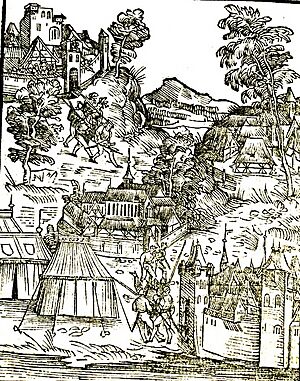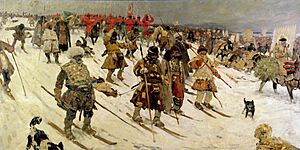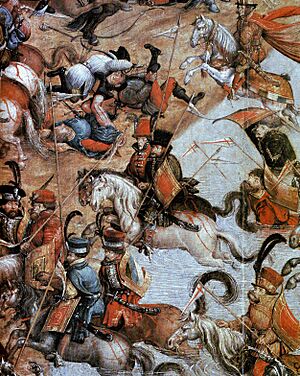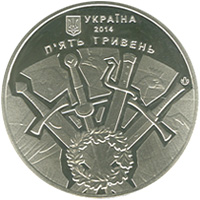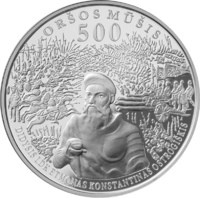Battle of Orsha facts for kids
Quick facts for kids Battle of Orsha |
|||||||
|---|---|---|---|---|---|---|---|
| Part of Lithuanian–Muscovite War (1512-1522) | |||||||
|
|||||||
| Belligerents | |||||||
| Grand Duchy of Lithuania Kingdom of Poland |
Grand Duchy of Moscow | ||||||
| Commanders and leaders | |||||||
|
Ivan Chelyadnin (POW) | ||||||
| Strength | |||||||
|
|
||||||
| Casualties and losses | |||||||
| 500 | 13,000–40,000 dead and wounded (?) At least 5,000 captured |
||||||
The Battle of Orsha was a big fight that happened on September 8, 1514. It was fought near the town of Orsha in what is now Belarus. This battle was between the armies of the Grand Duchy of Lithuania and the Kingdom of Poland. They were allies. Their leader was Konstanty Ostrogski. They fought against the army of the Grand Duchy of Moscow, led by Ivan Chelyadnin.
This battle was part of a long series of wars. These wars were called the Muscovite–Lithuanian Wars. The rulers of Moscow wanted to take over all the lands that used to be part of Kievan Rus'. This battle was a key moment in that long struggle. Some old records say that the Polish-Lithuanian army was much smaller. They say it was less than 30,000 soldiers. They defeated a huge Muscovite army of 80,000 soldiers. They even captured the enemy's camp and their commander. However, some modern historians think these numbers might not be totally accurate.
Contents
Before the Battle: A Growing Conflict
At the end of 1512, the Grand Duchy of Moscow started a new war. They wanted to take over lands in present-day Belarus, Ukraine, and Russia. These lands belonged to the Grand Duchy of Lithuania. At the same time, Albrecht I, a powerful knight, refused to promise loyalty to the Polish-Lithuanian king. This made things even more tense.
The city of Smolensk was a very important fortress. It was the eastern border of Lithuania. It protected the Duchy from attacks from the east. Smolensk fought off several attacks. But in July 1514, the Muscovite army surrounded and captured it. After this success, the Grand Prince of Moscow, Vasili III, sent his armies further into Belarus. They took over towns like Krichev, Mstislavl, and Dubrovna.
Meanwhile, the Polish-Lithuanian king, Sigismund the Old, gathered his own army. He had about 35,000 soldiers. Most of them were from Poland. Even though his army was smaller, it had many well-trained cavalry (soldiers on horseback).
The main Polish army was led by Janusz Świerczowski. It was the biggest army Poland had ever put together. Wojciech Sampoliński led other Polish groups. The Lithuanian soldiers, about 15,000 of them, were led by Hetman Konstanty Ostrogski and Field Hetman Jerzy Radziwiłł. The combined Polish-Lithuanian forces had 32,500 cavalry and 3,000 mercenary infantry (foot soldiers). King Sigismund kept about 4,000-5,000 men in the town of Barysau. The main army, about 30,000 strong, went to face the Muscovites.
In late August, there were some small fights. These happened at river crossings. But the Muscovite army avoided a big battle. They moved to an area between Orsha and Dubrovno. There, they set up their camp. Ivan Chelyadnin thought the Polish-Lithuanian army would have to cross one of two bridges over the Dnieper River. So, he split his army to guard both bridges.
However, Ostrogski's army crossed the river further north. They used two special floating bridges. On the night of September 7, the Polish-Lithuanian army got ready for the main battle. Hetman Konstantyn Ostrogski put most of his 16,000 Lithuanian cavalry in the middle. Most of the Polish foot soldiers and other troops were on the sides. Soldiers from Bohemia and Silesia were in the center. Behind them were backup groups of Lithuanian and Polish cavalry.
How Big Was the Muscovite Army?
The exact size of the Muscovite army is still a mystery. Old Lithuanian stories often say the Muscovite army was very large. King Sigismund wrote to Pope Leo X that there were 80,000 Muscovite soldiers. He also said his army killed 30,000 Muscovites. He claimed they captured 46 commanders and 1,500 nobles. But other Polish and Lithuanian papers only list 611 captured nobles by name.
Some historians think King Sigismund's numbers might have been for propaganda. This means he might have made the numbers bigger to make his victory seem more impressive. Another Polish historian believes the Muscovite army was about 40,000 strong. It's also unclear why King Sigismund kept 5,000 of his own soldiers as a personal guard. If the Muscovite army was so much bigger, why didn't he send all his soldiers into battle?
Some Russian historians have tried to figure out the size of the Muscovite army. They looked at how many soldiers different towns had to send. They think the army might have been around 13,000 to 15,000 men. This number includes servants. After losing soldiers during the journey and leaving some behind in Smolensk, the number of Muscovite troops at Orsha could have been as low as 12,000. Many modern historians agree with this smaller estimate.
The Battle Begins
On September 8, right after the sun came up, Ivan Chelyadnin ordered his army to attack. The Muscovite forces tried to go around the sides of the Lithuanian and Polish army. They attacked the flanks, where Polish, Lithuanian light cavalry, and Tartar troops were positioned. Chelyadnin led one part of the attack himself. Prince Bulgakov-Golitsa led the other.
The first attack didn't work, and the Muscovites pulled back. Chelyadnin still felt sure he would win. He thought his army was almost three times bigger. But he was so focused on his own part of the army that he didn't pay attention to other areas. He failed to prepare for a counterattack.
The Lithuanian light cavalry and Polish heavy cavalry had been waiting. They were kept as a surprise. These forces attacked the middle of the Muscovite lines. They tried to break them apart. At a key moment, the Polish cavalry seemed to hesitate. Then, they started to retreat. The Muscovites chased after them with all their cavalry.
But this was a trick! The Lithuanian Tartars and Polish cavalry suddenly turned to the sides. The Muscovite cavalry then found themselves facing artillery (cannons) hidden in the forest. From both sides, Lithuanian forces appeared. They quickly surrounded the Muscovites. Ivan Chelyadnin ordered a retreat. But the retreat quickly turned into a panicked escape. The Lithuanian army chased the fleeing Muscovites for five kilometers.
Many people believe the Muscovite defeat happened because Ivan Chelyadnin and Mikhail Golitsa failed to work together. They didn't coordinate their plans.
Sigismund von Herberstein wrote that 40,000 Muscovites were killed. Polish records say 30,000 Russians died. Another 3,000 were captured. This included Ivan Chelyadnin and eight other commanders. The Lithuanian army also captured the Muscovite camp. They took all 300 cannons. Grand Prince Vasili III was very upset. He reportedly said that "the prisoners were as useful as the dead."
What Happened Next
Ostrogski's army kept chasing the defeated Russian army. They took back most of the places the Russians had captured. This included Mstislavl and Krychev. The Russian advance was stopped for four years. However, the Lithuanian and Polish armies were too tired to attack Smolensk before winter. So, Ostrogski didn't reach Smolensk until late September. This gave Vasili III enough time to prepare its defense.
In December, Hetman Konstanty Ostrogski entered Vilnius in triumph. To remember the victory, two Orthodox churches were built. These were the Church of the Holy Trinity and the Church of Saint Nicholas. They are still beautiful examples of Eastern Orthodox Church buildings in Lithuania.
Right after the victory, Poland and Lithuania used the battle for propaganda. They wanted to make their country look good to other nations in Europe. They sent many proud stories about the battle to Rome. They wanted to show that Muscovites were not true Christians. They said Muscovites were cruel and worked with Turks and Tatars to harm Christian Europe.
The Holy Roman Emperor, Maximilian I, was impressed by the Polish-Lithuanian victory. He started talking about peace with the Jagiellons in Vienna. On July 22, 1515, they made final peace agreements. The big group of countries that were against Lithuania and Poland broke apart.
The war between the Grand Duchy of Lithuania and Grand Duchy of Moscow continued until 1520. In 1522, a peace treaty was signed. Lithuania had to give up about a quarter of its lands that used to be part of Kievan Rus'. This included Smolensk. That city was not taken back by Lithuania until almost 100 years later, in 1611. After the 1522 peace, there were no major wars between them for about 40 years.
The Battle Today
Some people in Belarus see the Battle of Orsha as a symbol of national pride. They even call it a Day of Belarusian Military Glory. On September 8, 1992, which was 478 years after the battle, military students in Minsk took their first oath to the Armed Forces of Belarus. This happened on Independence Square.
However, as Belarus became closer to Russia, the government stopped celebrating the battle. In September 2005, four people were fined a lot of money for celebrating the battle's 491st anniversary.
Ukraine also celebrates the Battle of Orsha. They see it as an important victory in their history of conflicts with Russia. On October 14, 2014, Ukraine's National Bank made a special coin to remember the battle's 500th anniversary. There is also an Orsha Victory Street in Rivne, Ukraine.
In Warsaw, Poland, the Battle of Orsha is remembered at the Tomb of the Unknown Soldier, Warsaw. The inscription there says "ORSZA 8 IX 1514".
In Lithuania, the Ministry of Defense and the government celebrate the Battle of Orsha every year. They hold concerts, conferences, and military parades.
Legacy of Orsha
In 1514, to show thanks for the victory, Konstanty Ostrogski built the Church and monastery of Holy Trinity in Vilnius.


